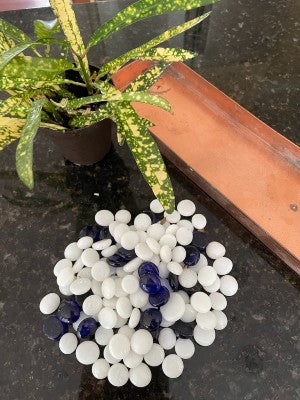 By Karen Weir-Jimerson
By Karen Weir-JimersonWet pebble trays are a low-tech way of providing humidity for your houseplants.
Plants love humidity, especially in winter when heated indoor spaces also mean drier air. You can plug in a humidifier to add moisture to the air in your home. But there’s also other ways to boost the humidity around your plants in a low-tech (and very attractive!) way: the wet pebble tray.
What is humidity (and why do plants love it)?For plants, water means life. Plants use hydration in several forms -- the pourable kind (think water from a watering can) and the vapor kind (from moisture in the air). The concentration of water vapor in the air is called humidity. Some plants harvest moisture directly from the air, “drinking” in moisture through their leaves. Proper hydration is part of a plants’ ability to photosynthesize. Warm air holds more humidity than cold air.
How much humidity do indoor plants need?
Most houseplants prefer humidity levels between 40 and 60 percent. But that doesn’t mean you need to make your home feel like a swamp. The Environmental Protection Agency recommends keeping your home at between 30 and 60 percent humidity level for human health (this reduces harmful molds from growing). So the good news is that most plants and their parents will thrive in the same levels of humidity.
 Measuring humidity
Measuring humidity You can measure the humidity level around your houseplants with a tool called a hygrometer. But you don’t need a measurement tool to gauge humidity levels. Your houseplants will tell you when they aren’t getting enough humidity; their leaves tips will get crispy.
Boosting humidity around plants
There are several ways to add humidity around your plants. The aforementioned humidifier is a way. But there are less dramatic ways to create a humidity “dome” around plants. Start by grouping your plants together. Plants drink in moisture, but they also breathe it back out (called transpiration). So when your plants are crowded together, they benefit from the moisture that each emits.
Humidity from the ground up
A natural way for plants to get more moisture is from the ground. But overwatering your plants can cause their roots to become too wet and rot. So a simple solution is to water the area below the plant where the roots can’t become waterlogged: hence wet pebble trays. This low-tech system is simply a tray, plate, or sauce tilled with stones and water that a plant can sit on top of. The benefit is that the water from the tray evaporates, causing water vapor to rise around the plants. Instant and consistent hydration from localized humidity.
What you need
-- Tray, platter, dish that will hold water
-- Pebbles, seaglass, shells -- anything that will lay flat enough for pots to sit on
-- Water

Here are tips for creating a low-tech humidifier for your plants.
-- Fill a tray with pebbles to the top of the tray. The space between the pebbles will allow water to fill the tray.
-- Make sure the pebbles create a level surface on which the pots can sit.-- Place the plants on top of the pebbles. They should sit on top of the pebbles, not nestled into the pebbles.
-- Fill the tray with water so that it surrounds the pebbles. Don’t allow the water level to rise above the pebbles. You don’t want your container sitting in water, you want the container to be sitting above the water.

















